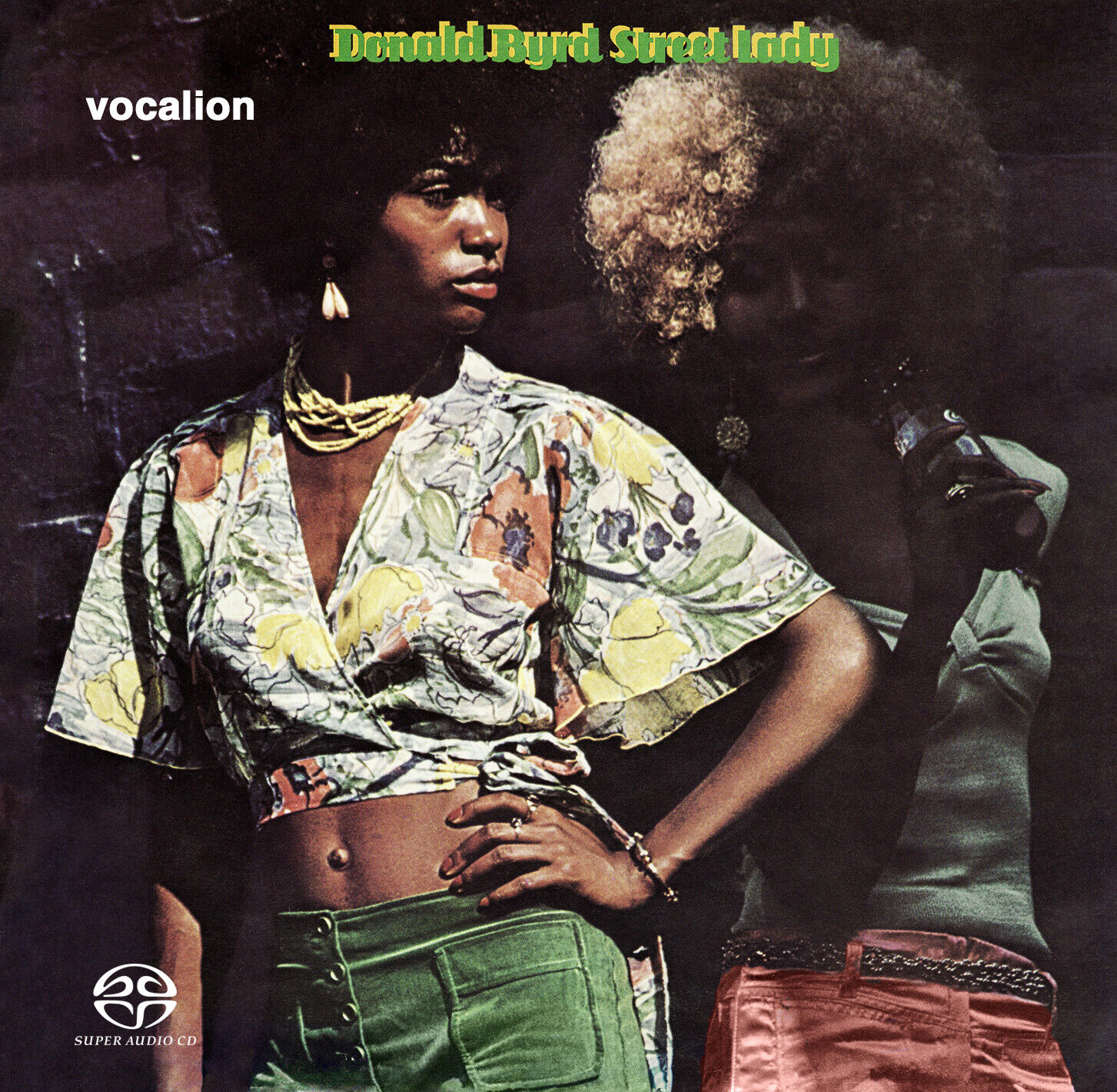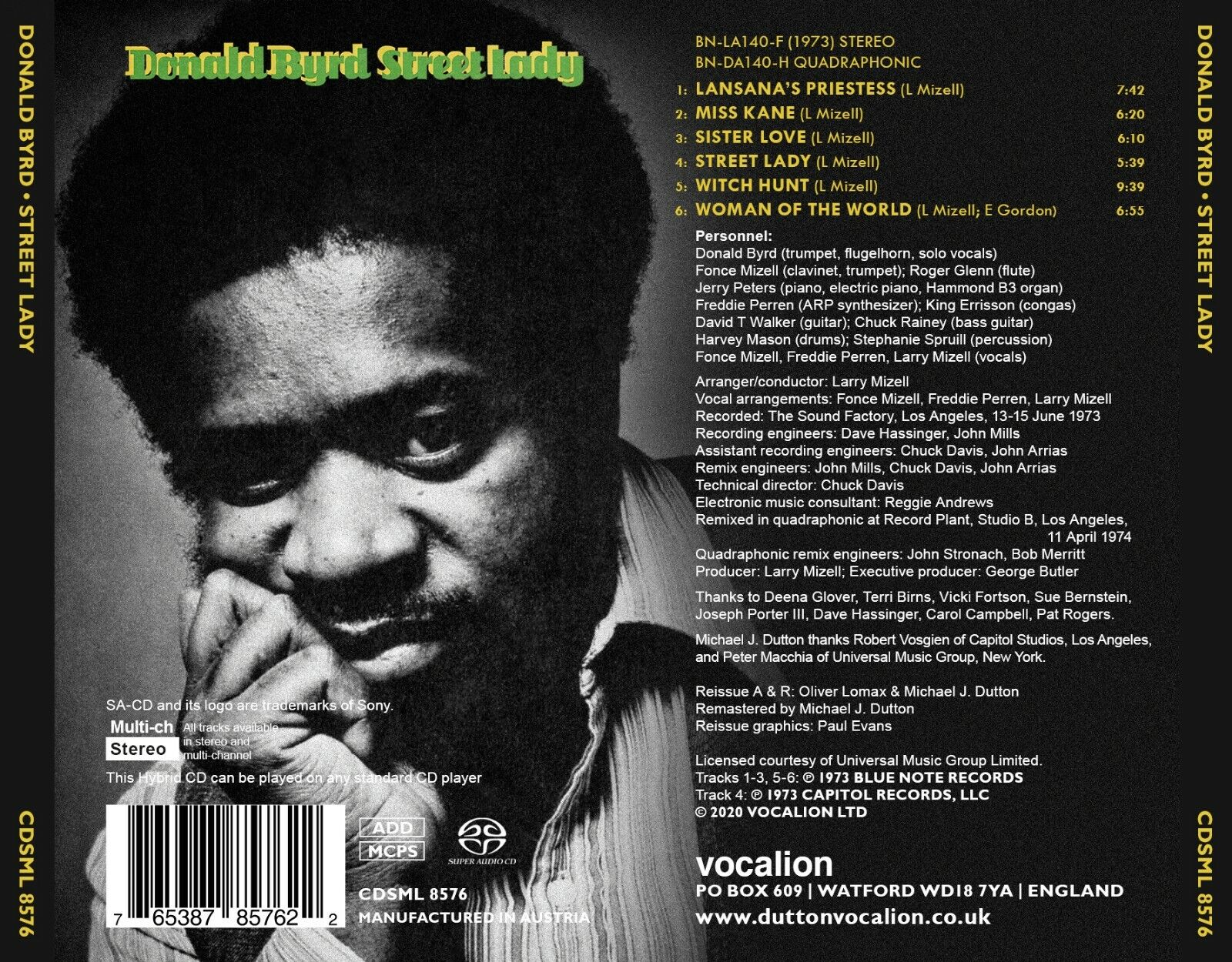I suspect that not many people have picked this up yet because it was part of a batch of releases that included easy listening albums and broadway musicals, but if you liked D-V's release of
Black Byrd, or this type of jazz-funk at all, you owe it to yourself to add this to your order when the next batch of D-V pop releases drops.
For some reason,
Black Byrd seems to get the attention (maybe because it was Byrd's first foray into this kind of music) but for me this is a superior album in every way - the songs are more interesting and more varied, there are less unnecessary vocals, and the band is somehow tighter and more assured, but also looser and far more improvisational. This is absolutely an album underpinned by funk, but the various soloists (Byrd, on trumpet, Roger Glenn on flute, and Jerry Peters on organ and piano) get a lot of room to stretch out - I felt like at times on
Black Byrd that Byrd himself was kind of a passenger on his own album while the Mizell brothers were driving, but on this one really feels more like it was contstructed to highlight his playing.
And the band, wow, if you were going to make an album in this style at this time, you couldn't really do much better than the musicians that are on this album. Drummer Harvey Mason was fresh off his stint with Herbie Hancock's
Headhunters band, and Chuck Rainey was about to become Steely Dan's go-to bassist (there isn't a much higher accolade than that, in my book) for the next half-dozen years. The album also features one of the tastiest rhythm guitar players of the 70's, David T. Walker, who has about a million session credits to his name including Marvin Gaye's
What's Going On and Stevie Wonder's
Innervisions, and would later replace Larry Carlton in the Crusaders.
The two keyboard players on the album are really interesting too, because they're both more well known for their work as producers and songwriters -
Jerry Peters (who plays piano, electric piano, and organ here) with the Friends of Distinction, and
Freddie Perren (who plays synthesizer here) who co-wrote a bunch of the Jackson 5's hits (ABC, The Love You Save, etc.) before this album, and then later went on to produce and/or write hits for Gloria Gaynor (I Will Survive), The Miracles (Love Machine), Tavares, Peaches and Herb (Shake Your Groove Thing, Reunited) and later on, New Edition.
I mentioned Byrd and Glenn getting the opportunity to stretch out a lot, and it's almost always over a 1 or 2 chord vamp - what this album really is a masterclass in is how all these backing musicians can sit on a single chord, or simple riff, for 2 or 3 minutes or more, and find ways in their playing to not only make things interesting, but to make the music feel like it's leading somewhere, and building up to something, rather than just being monotonous. I think this is one of the ways the quad mix (more on that in a moment) really shines, because you can really focus on the interplay between the musicians, and pick out when one of them is responding to something another is doing. There are a couple of great moments where Peters' piano playing pushes Mason to get busier and busier with his drumming until the whole thing reaches the turnaround and they lock back into the main groove.
Perren's synthesizer really adds a new dimension to Byrd's sound too, forming the basis for several of the songs, and I love the fact that Byrd wasn't afraid to alter the sound of his trumpet either, and he does it even more on this album, with various effects. There are also a couple of songs where it sounds like Glenn's flute is running through some sort of phaser or Uni-Vibe type effect - the net result is that the lines between all the instruments are blurred, and it becomes a case of "what does it sound like?" rather than "what instrument is making that sound?" and I love that. Byrd and Miles both came out of the same era of jazz, and it seems like Byrd took a lot of stick for taking the "commercial" (read: artistically bankrupt, according to critics) route, but his playing on albums like this did as much to expand the horizons of jazz-fusion as Miles did on his own albums. Not to mention the fact that the one-chord vamp improvisations aren't a million miles away from the approach that characterized Miles modal period (
Kind of Blue, etc.) which produced some of his most heralded work.
Before I get to the quad mix, I have to say that the fidelity of the quad mix is absolutely stunning. If this isn't the best sounding disc that D-V have done to date, it's definitely in the top 3 for me - I actually said "wow" out loud when the drums kicked in for the first time, because there's some real low-end energy here...on a lot of 70s recordings the bass drum will pop, or pang, or bong, but on this disc it hits you square in the chest in the best way possible. The high end it just as exquisite - I've come to believe this is maybe the signature facet of Mike Dutton's masterings, that the upper mids have this remarkable lifelike quality (there are a few moments on this album where Glenn's flute sounds like it's in the room with you) but that the real top end (hi-hats, et. al) never sizzles with harshness or sibilance. It's also worth noting that former Rhino Quadio engineer (and sometime QQ vistor)
@Bob Vosgien was involved with the analog to digital transfer of the master tape, and he deserves credit for his part in the superb quality of this disc.
When D-V were working on this release they sent me a photo of the quad master tape box because they were trying to work out who was responsible for the mix and the box only had the engineer's initials on it. I was surprised to see that the tape had Record Plant LA logos on it (I was under the impression thanks to a
Billboard article, that U/A did all its quad mixing in-house) but even more surprised when I realised the initials 'JS' were John Stronach, because he'd never been previously connected to this album in any way. I own the Q8 of this album, but honestly, it'd been 10 years at least since I'd listened to it, and given the terrible quality of the U/A Q8s (more on the label, its quad history, and those terrible tapes
here) I had no real recollection of the mix so I was really curious what Stronach would do, especially given that his other two quad remix credits were for mixes beholden to matrix quad mixing rules: Sly Stone's
Small Talk and Joe Walsh's
So What (unreleased, but two tracks appear on the
Koss Perspectives QS sampler LP). I don't want to oversell this, and I also don't want to give too much away, because I think half the fun of discovering a quad mix is when things literally sneak up on you from behind, but for me, Stronach turned in an absolute stunner of a mix, one that betters the stereo in every way. Freed from the limitations of matrix-quad mixing, he's able to put instruments wherever he wants, and the result is a mixture of four-corner discrete elements, and more "in the room" type mixing - I haven't torn the mix apart, but it seems like the drums are in all four speakers, but neither in a 'double stereo' way, nor in a 'main kit in the front/tom toms and cymbals in the back' kind of way either, it just feels like they wrap around you. The whole album feels that way in fact - if the goal of surround mixing is to put you in the middle of the performance, I don't think many quad mixes have succeeded as well as this one does. Stronach also makes liberal use of swirling, "round the room" pans of both instruments and vocals, but he does it in a really thoughtful and intelligent way that doesn't feel gimmicky at all - instead it gives the mix an exciting (and sometimes surprising) playful quality. The instrument balances are also perfect - there's nothing buried, no straining to hear an instrument that was prevalent in the stereo mix, nothing out of whack. If this mix somehow had a fifth channel with dedicated center-channel content, I think you'd have a tough time telling it apart from a modern Steven Wilson or Elliot Scheiner remix. I can't believe (and I thought about this a lot when I was listening to it) that previous to this SACD, this mix was confined to some of the worst-sounding consumer media of the last 50 years, with the frequency response of U/A Q8 tapes topping out in the 6-7kHz range.
Having said all that, I don't think this album is a 10, and that's only because some of the songwriting is a bit threadbare (especially on the title track) compared to some of the other titans of this genre, like Weather Report, Return to Forever, Herbie Hancock, Deodato etc. I also could've done without some of the vocals (again on the title track) but it's a relatively minor quibble, and one I'm willing to live with because one of the things I love about this album is how unapologetically 70s it is, and I guess those vocals are just part of the package. But like I said previously, if you're buying this album, it's for the players, the playing, and the almighty groove, and if those kinds of things float your boat you can't go wrong with this release.



























